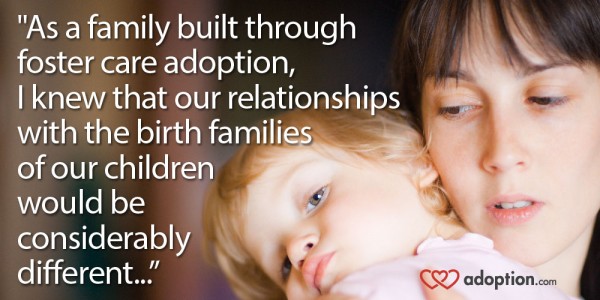As a family built through foster care adoption, I knew that our relationships with the birth families of our children would be considerably different than those in a different type of adoption.
In an international adoption, for instance, we would likely never have had contact with our child’s birth family in the process.
In an open domestic adoption, we would likely have had some contact and possibly even quite a lot. I have read so many accounts, in fact, of the beautiful relationships built between birth mothers and adoptive families. It’s so tender to see families come together in one purpose.
There are foster families who are able to create openness with birth families in their adoptions, and when it works, it is amazing. We are working towards a measure of this where possible, but it is a delicate balance to find. I know it might seem obvious, but as a prospective foster mother, I didn’t quite anticipate the difficulty. As I sat in training classes, I imagined meeting our foster children’s parents, hugging them and crying together, deciding that we would work as a team to make the best life possible for the children we both love.
That last part is entirely true: our children are very much loved by two families.
One important difference that I hadn’t considered in my eagerness is that in foster care adoption, the choice by a birth parent to place a child is usually replaced by the compulsory removal of the child. No matter the circumstances, this removal is traumatic for all involved. In our experience, though there were very valid reasons for our kids to be placed in a home away from their birth families, those reasons were difficult for our children’s birth families to see. They felt their children should never have been removed.
I’m going to be honest: Every emotion I expected to feel toward our children’s birth family has been stronger than anticipated. There is anger, yes, for the situation that hurt my children, for their trouble accepting responsibility. But the compassion, too, is stronger. The love I feel for the people who held these babies first is more than I thought I could have for virtual strangers.
The depth of this relationship with people that I do not see is confusing, and yet it feels natural.
The want to come together, even now that I can better see the walls that hinder us, is stronger.
Ultimately, reuniting families is the goal of foster care. We agreed to love and care for these children while their families worked toward reunification. We understood that there would be loss and heartbreak in either outcome.
For our children and their birth families, reunification didn’t happen.
We were at court during the trials conducted to terminate their parental rights.
We didn’t hug. I know that we all cried, but we didn’t do it together.
Though any foster parent can attest to the fact that as such we have almost zero control over the outcome of a case, to our children’s birth families, I felt in that courtroom that we were mostly the people who took their children from them.
Deciding what is safe and appropriate with the present circumstances is challenging. Currently, we have one adoption where safety concerns are strong, and we are not seeking contact right now. In another adoption, we have some beginning contact and are deciding how to maintain that, and whether we take any steps beyond is up to us or our child to decide on later. The response to our correspondence varies quite a lot.
But healing happens. Pain lessens, children learn to trust, and parents learn to forgive their past.
Hopefully, one day we can all hug and cry and love together. Until then and always, I want my children to grow up understanding how much I want that for all of us, not learning to view their birth family as the competition.
If you have been a foster parent, how have you navigated your relationship with your child’s birth family?

